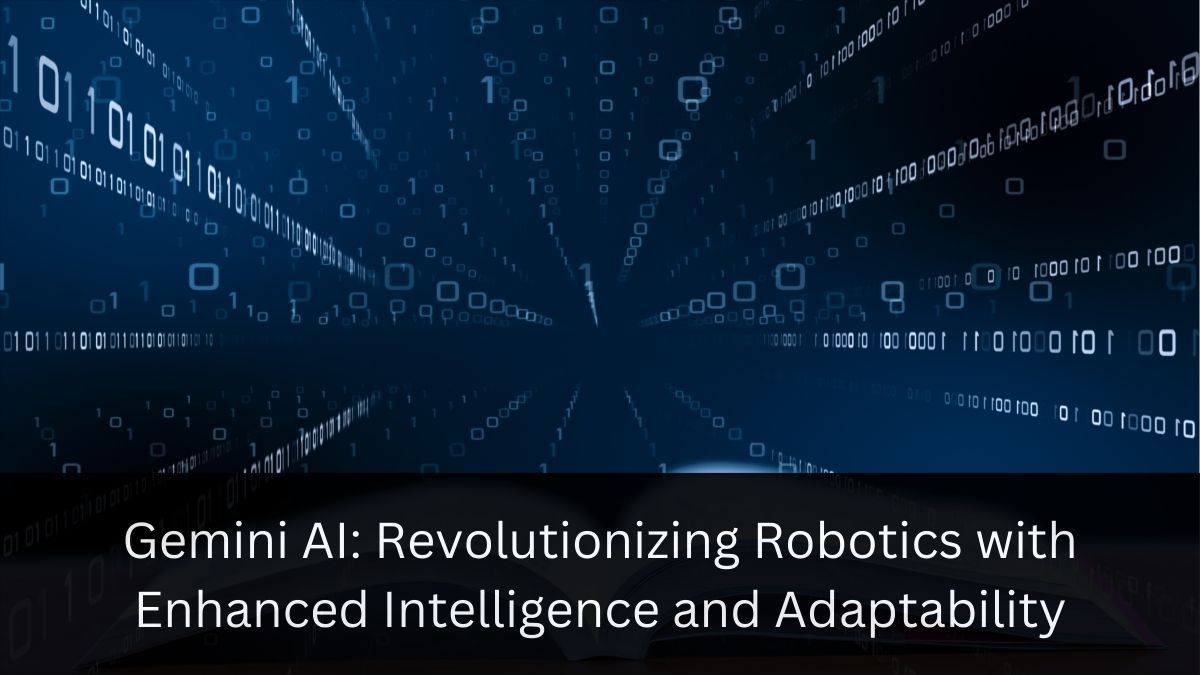AI
Gemini AI: Revolutionizing Robotics with Enhanced Intelligence and Adaptability

In the ever-evolving landscape of artificial intelligence and robotics, Google’s latest breakthrough is turning heads and sparking imaginations. The tech giant has announced that its Gemini AI is making significant strides in enhancing the capabilities of robots, particularly in the realms of navigation and task completion. This development marks a crucial step towards creating more intuitive and adaptable robotic systems that can seamlessly interact with human environments.
The Power of Gemini 1.5 Pro
Unlocking New Possibilities with Long Context Windows
At the heart of this advancement lies Gemini 1.5 Pro, the latest iteration of Google’s AI model. What sets this version apart is its impressive long context window, a feature that dramatically expands the amount of information the AI can process simultaneously. This capability is proving to be a game-changer in the field of robotics.
Imagine trying to explain a complex task to someone who can only remember the last few words you’ve said. Now, contrast that with explaining the same task to someone who can effortlessly recall and process an entire conversation. That’s the difference Gemini 1.5 Pro brings to the table in the world of human-robot interaction.
From Video Tours to Virtual Understanding
One of the most fascinating aspects of this technology is how it leverages visual learning. Researchers have developed a method where they can essentially give a robot a “video tour” of an environment, such as a home or office space. The Gemini AI then “watches” this video, meticulously analyzing and learning about the layout, objects, and potential interactions within the space.
This process mimics how we, as humans, familiarize ourselves with new environments. We don’t just memorize a map; we observe, interact, and build a mental model of our surroundings. Gemini is bringing this human-like adaptability to robots, allowing them to understand and navigate spaces with unprecedented flexibility.
Practical Applications and Impressive Results
Navigating the Real World
The implications of this technology are vast and exciting. In trials conducted by Google’s DeepMind robotics team, robots powered by Gemini 1.5 Pro demonstrated remarkable proficiency in following natural language instructions within complex environments.
For instance, when asked, “Where can I charge this?” while being shown a smartphone, the robot could navigate to the nearest power outlet. This may seem simple, but it requires a sophisticated understanding of the object (the phone), the concept of charging, and the physical layout of the space.
Beyond Navigation: Task Planning and Execution
What’s truly impressive is that the Gemini-powered robots aren’t just glorified GPS systems. The research team found “preliminary evidence” suggesting these robots can plan and execute multi-step tasks based on verbal instructions.
Consider this scenario: A user with several empty soda cans on their desk asks the robot if their favorite drink is available. The Gemini AI doesn’t just process this as a simple yes or no question. Instead, it formulates a plan:
- Navigate to the refrigerator
- Inspect the contents for the specific drink
- Return to the user and report the findings
This level of task decomposition and planning showcases a leap towards more autonomous and helpful robotic assistants.
The Numbers Speak: Impressive Success Rates
In controlled experiments, the Gemini-powered robots demonstrated a staggering 90% success rate across over 50 diverse user instructions. These tests were conducted in a sprawling 9,000-plus-square-foot operating area, highlighting the system’s ability to function effectively in large, complex spaces.
As someone who has followed the development of home robotics for years, I find these numbers particularly exciting. Previous attempts at creating versatile home robots often struggled with reliability, especially in varied environments. This 90% success rate in a large, real-world setting is a significant milestone.
Challenges and Future Directions
The Processing Time Conundrum
While the video demonstrations provided by Google are undeniably impressive, it’s important to note that there’s still room for improvement. According to the research paper, the current system takes between 10 to 30 seconds to process each instruction. In a world accustomed to near-instantaneous responses from digital assistants, this delay could be a hurdle for widespread adoption.
However, as someone who remembers the early days of voice recognition technology, I’m optimistic about the potential for rapid improvement in processing speeds. Just as we’ve seen with other AI technologies, what seems slow today could become lightning-fast in a matter of months or years.
Ethical Considerations and Privacy Concerns
As we edge closer to having AI-powered robots in our homes and workplaces, it’s crucial to address the ethical implications and privacy concerns that come with this technology. The ability of these robots to observe and learn from their environment raises important questions:
- How is the data collected by these robots stored and protected?
- What are the limits to what these robots can observe and report?
- How do we ensure that this technology is used responsibly and ethically?
These are complex issues that will require ongoing dialogue between technologists, ethicists, policymakers, and the public.
Looking Ahead: The Future of AI-Enhanced Robotics
The integration of Gemini AI into robotics is more than just a technological advancement; it’s a glimpse into a future where our interaction with machines becomes more natural and intuitive. As this technology continues to evolve, we can anticipate:
- More Versatile Home Assistants: Imagine robots that can not only find your missing keys but also learn your daily routines and proactively assist with household tasks.
- Enhanced Accessibility: For individuals with mobility challenges, these advanced robots could provide unprecedented levels of independence and support.
- Revolutionized Workplace Efficiency: In industrial and office settings, robots with enhanced spatial awareness and task-planning abilities could dramatically improve productivity and safety.
- Advancements in Eldercare: As populations age, AI-powered robots could offer companionship and assistance, helping seniors maintain independence for longer.
As we stand on the brink of this new era in robotics, it’s clear that the integration of advanced AI like Gemini is set to redefine our relationship with machines. While there are still challenges to overcome and ethical considerations to address, the potential benefits are immense.
The day when we share our homes with truly intelligent, adaptable robots may be closer than we think. As this technology continues to evolve, it will be fascinating to see how it shapes our daily lives, our workplaces, and our society as a whole.
What are your thoughts on this exciting development? Are you looking forward to having an AI-powered robot assistant in your home, or do you have concerns about the implications of this technology? Share your opinions and let’s continue this important conversation about the future of AI and robotics.
